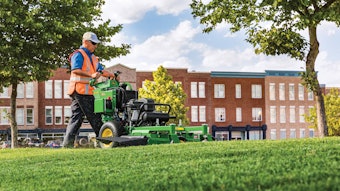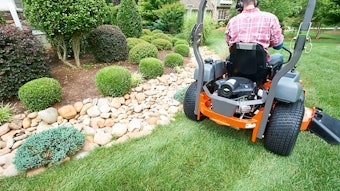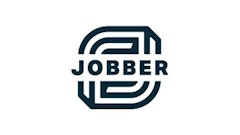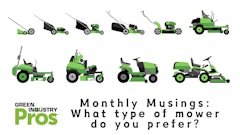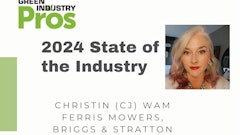
As the number of lawn and garden dealers has continued to dwindle, more dealers are feeling as though their voice has been lost. As one dealer put it, “Manufacturers act like we need them to survive, but I think they need us more. Until all outdoor power equipment becomes disposable, dealers are badly needed.”
Servicing dealers are undoubtedly needed. The question is: how many?
According to the U.S. Census Bureau, the number of “lawn and garden equipment and supplies stores” dropped 12% from 2002 to 2008. The number of “outdoor power equipment stores” specifically dropped 7%. The attrition of service-only businesses has been even more dramatic. The number of “lawn and garden equipment repair and maintenance” businesses has dropped 28% since 2004, and 47% since 2001.
Nonetheless, 2002-2008 represented a period of strong growth in the industry. Now—post-economic collapse where consumers are hanging onto equipment longer and altogether shopping differently—Green Industry observers wonder just how many equipment retail and/or service centers are needed to satisfy demand.
Regardless of the number, it’s important to remember that the manufacturer/dealer relationship is symbiotic. The North American Equipment Dealers Association (NAEDA) is trying to draw attention to that often disregarded fact. They’ve established an OPE Industry Relations Task Force that will regularly bring dealers and manufacturers together to discuss important issues.
Internet selling
Selling parts and equipment on the Internet is at the top of the priority list, according to Mike Williams, NAEDA’s treasurer and vice president of government relations. How pricing is published and how territories are protected are among the biggest challenges.
Manufacturers selling direct to end-users is definitely a growing issue. Dealers are also concerned about heavily discounted Internet prices. When a consumer sees this type of pricing on the Internet, and then stops into a dealership and sees the dealer’s price, the dealer is put into a difficult position.
The same can be said for parts. “It’s not that dealers feel they can’t compete when it comes to Internet parts sales,” Williams points out. “The problem emerges when you have someone who’s undercutting everyone else and then gets rewarded with a volume discount.”
“With outdoor power equipment there aren’t always well-defined territories,” says Paul Kindinger, president and CEO of NAEDA. “On the ag side there are, so there are more ways to police and control Internet selling.” For instance, financial incentives that encourage dealers to only sell within their territory sometimes prove effective.
That doesn’t stop the box stores or online wholesalers like Power Equipment Direct from doing what they do, though. “There are way too many Internet sites selling parts and equipment,” one dealer said. “Manufacturers say they monitor it closely, which I don’t think is true. But if they do monitor it, they sure don’t do much about stopping it.”
The problem is that the Internet is becoming too enticing for some to resist. Roughly 163 million people bought something online in 2009. That number is expected to grow to 201 million by 2015. Online retail sales are soon expected to surpass the $200 billion-per-year mark.
It’s not just books, video games and shoes that consumers are buying online either. Small appliances and garden tools both made the top 20.
“The Internet has some outstanding potential for us dealers to benefit from,” says Josh Ahearn of Ahearn Equipment in Spencer, MA. “We’re hoping that manufacturers will work to adopt comprehensive Internet marketing policies. Overall I’m not opposed to Internet selling, as long as it’s locally targeted and done responsibly. It would also help if manufacturers did more to educate consumers on the benefits of purchasing equipment locally.”
Many dealers are on the same side of the fence as Ahearn. The Internet now presents a huge sales opportunity that can’t be missed—but online sales should always be channeled through the appropriate dealer.
For example, one dealer says he was compensated by his distributor for an online transaction he never put a finger to. The distributor took the order and shipped the product to the consumer, and the dealer received a credit for just under full margin.
Aftermarket parts suppliers that sell and ship directly to consumers is especially frustrating for dealers. “We can fill email or phone orders no problem,” one dealer said. “Make the customer go through us. On the one hand you’re telling (dealers) to stock a bunch of parts, but then you turn around and sell parts directly to our customers.”
Internet sales are not only depriving dealers of business, but are also robbing local communities of tax revenue, according to Lynn Pesson Jr. of Lafayette, LA-based Southland Engine. “Each state should pass a law requiring Internet sellers to charge taxes,” Pesson says. “This way everyone is competing on the same level, and our suppliers would not have to police it. Customers would more likely go to the local dealer, and the states would have the tax dollars they need to support our communities.”
Internet selling aside, simply advertising on the Internet is something dealers are also concerned about. The OPE Industry Relations Task Force is looking to address this issue as well.
“Most manufacturers don’t provide any co-op benefit for online advertising,” Ahearn points out. “This would enable dealers to increase their local online presence, which is quickly becoming the most important and effective advertising tool. At the same time, it would inhibit dealers who sell online and outside of their area by not providing co-op for online advertising that is outside of policy guidelines.”
Regulation
The OPE Industry Relations Task Force is also looking at the increasing amount of government regulation that’s affecting the Green Industry. Public policy related to taxes, immigrant labor, water quality and conservation, and alternative fuels such as E15 (gasoline with 15% ethanol) are of great concern.
“Dealers want to work more closely with manufacturers so their voice is heard,” Kindinger reiterates. “Whenever we can find an opportunity to work together and come across as a united industry, the better off we’ll be.”
Are we in this together?
“We’re looking to build more rapport between dealers and manufacturers, plain and simple,” Williams adds. Good timing. The economic challenges of the past few years have put additional strain on the dealer/supplier relationship. Manufacturers and distributors have been scrambling to grow sales by increasing market share—not an easy task when demand is weak and the number of dealerships is limited.
Territory protection is often the biggest bone of contention. Dealers who grow sales of a particular brand in a particular area are often “rewarded” with additional dealers who’ll be selling that same brand. This is why more and more dealers feel as though investing in a manufacturer’s line is risky these days.
“Dealers were protected years ago,” says Illinois dealer Kenneth Tease of Harold G. Tease & Son. “A dealer felt an obligation to make his brand a leader in his area. Today it seems like you only have to be breathing to become a dealer.”
This lack of territory protection is one reason why many dealers are becoming increasingly concerned about investing in large orders. Yet the pressure to do so persists.
Randy Longnecker of Olympia, WA-based J&I Power Equipment says his dealership hasn’t had many issues with suppliers attempting to overstock them with wholegoods inventory. But he sees it happen elsewhere, especially when a dealer takes on a new line that’s already well supported by another dealer in the area.
“The new dealer goes through an initial excitement of how easy the product sells due to its reputation,” Longnecker says. “This same dealer is also quick to discount, either because of the large stocking investment of a new product line or as an attempt to buy customers from a dealership they most likely competed against prior to this addition. In either case the new dealer is primed for overstocking, which breeds discounts.” Longnecker adds that new dealers who are prone to discounting have strained his dealership’s margins more than any recession has.
Some dealers would like to see a change in the way manufacturer and/or distributor sales reps are compensated. Most compensation plans encourage sales reps to sell as much as they can and/or set up as many dealers as they can. Conversely, incentives that tie rep compensation to dealer sell-through can help strengthen the dealer/supplier partnership—forcing both parties to work together to ensure the success of a given brand in a given market area.
That can be a scary proposition for some suppliers, though. There are far fewer dealers than their used to be, and the big ones keep getting bigger—making it harder for the smaller ones to compete. Growing market share is unfortunately not just a matter of being loyal to a dealer network. It’s a matter of assembling the right dealer network where loyalty is reciprocal.
“It’s too easy to point the finger at someone else,” Pesson says. “Dealers need to understand that doing business is not always easy. That said, one thing we can blame suppliers for is how easy they’ve made it to take on a new product line. In many instances they’ve lowered the dollar amount to become a dealer, they’ve added more co-op dollars for new dealers, they give new dealers ‘best bracket’ pricing and rebate checks at the end of the year, and the list goes on. The end result is dealers selling too many lines, causing the problem we have today.”
“The main thing our OPE Industry Relations Task Force is looking to do is build good communication and relationships between dealers and manufacturers,” NAEDA’s Kindinger says. “Then we can have open, frank discussions based on trust.”

